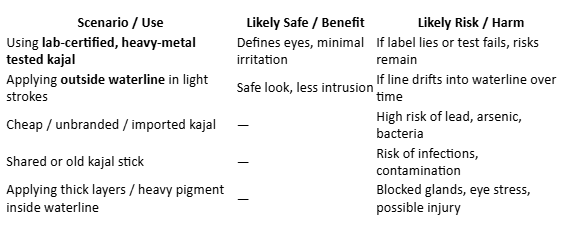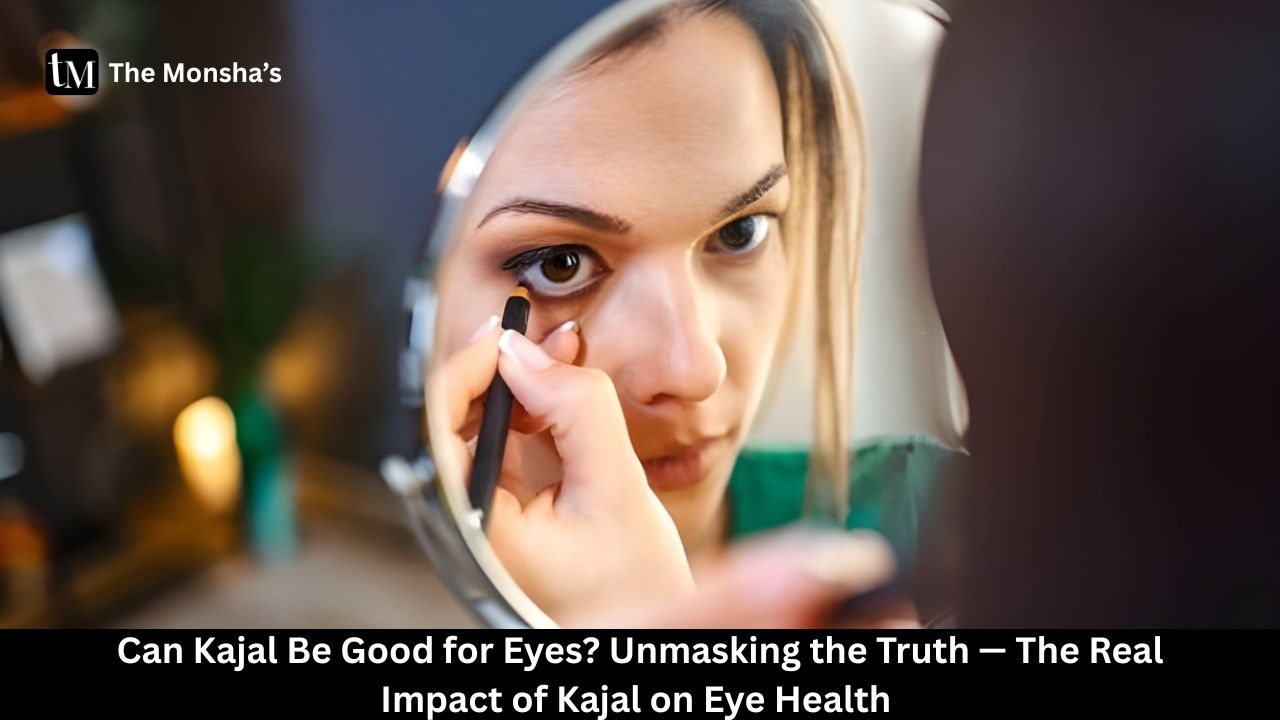TL;DR
Yes, kajal can look stunning — but its safety for your eyes depends entirely on what’s in it, how you use it, and who’s applying it. Many traditional kajals (and kohls) carry heavy metals like lead, posing serious risks. Choose lab-tested formulas, follow safe practices, and don’t sleep with it on.
What Is Kajal? — Tradition Meets Modern Beauty
Before we judge it, let’s understand it.
- Kajal, often called kohl in everyday chat, is a time-honored eye cosmetic in South Asia, the Middle East, and beyond. Traditional recipes use soot (lamp black), oils (coconut, almond), camphor, herbal extracts.
- It has cultural weight — mothers sometimes applied mild kajal on infants’ eyes as a “protective charm” (haan haan, nani ke upaay vibes 😄).
- Today you’ll find commercial kajals: wick pencils, gel sticks, smudge sticks, even “waterline safe” variants — but formulations vary wildly.
So “kajal” is a broad umbrella — some versions are gentle, others are ticking bombs.
Positive Claims — What People Say Kajal Does
Why do people love it (besides the look)?
- Cosmetic enhancement — defines the eyes, adds depth and drama
- Cooling / soothing feel — especially in hot, dusty climates
- Herbal or oil-based benefits — some brands infuse neem, aloe, etc., claiming they nourish eyelids
- Cultural / traditional belief — in some households, kajal is thought to shield eyes from “nazar / evil eye,” glare, or dust
These are all compelling — but beauty without safety is like candy without sugar (a bit pointless).
The Dark Side — Risks, Side Effects & Scientific Warnings
This is the part I woke up for.
Heavy Metals & Toxicity
- Multiple studies on traditional kajal / kohl have found high levels of lead (Pb) and other toxic elements. In one analysis, traditional eye cosmetics showed lead concentrations many times higher than safe limits.
- One public health investigation showed that imported traditional eyeliners had lead concentrations so high they became a suspect source of childhood lead poisoning.
- In lab-tested kohl items sold in certain countries, lead levels far exceeded regulatory thresholds.
- Aside from lead, substances like cadmium, antimony, arsenic have been detected in some variants.
- These heavy metals can accumulate in body tissues (brain, bones) and may disrupt neurological function, cause anemia, developmental issues — especially in children or pregnant users.
Important note: Even small amounts of lead are harmful. The Centers for Disease Control (CDC) states there’s no safe lead threshold for humans.
Irritation, Infections & Eye Disorders
- Kajal can irritate delicate eyelid skin, especially in individuals with sensitive / allergic eyes.
- If applied too close to the waterline repeatedly, it may block or stress Meibomian glands (oil-producing eyelid glands), leading to dryness, inflammation, or blepharitis.
- Using old, contaminated kajal or sharing the stick invites bacterial or fungal infections.
- Sleeping with kajal on is a recipe for clogged tear ducts, eye strain, and microbial build-up.
- Excessive rubbing (while applying or removing) can cause microabrasions on the cornea or conjunctiva.
In short: kajal isn’t inherently evil, but many practices raise the risk.
When Kajal Helps vs When It Harms — Decision Table

Use the table as your quick litmus test — but always dig deeper (read the label!).
How to Use Kajal Safely — Best Practices
Let’s roll up sleeves and do this right (even my eyes are tired writing this).
Choosing the Right Formula
- Pick reputable brands that publish heavy metal / toxicity tests
- Look for “ophthalmologist tested,” “dermatologist tested,” “lead-free” labels — but don’t blindly trust.
- Avoid ambiguous terms like “traditional,” “home-made,” “imported old stock” unless validated.
- Prefer “waterline-safe” only if the product’s test data supports it (some brands specify safe for waterline).
Application Wisdom
- Cleanse lids gently and dry them.
- Warm the tip slightly (rub on clean tissue/fingers) for smoother glide.
- Apply light strokes, gradually deepen — don’t force full pigment in one go.
- Keep a small gap from the inner rim (unless formula explicitly allows waterline).
- Smudge edge if you want smoky effect; don’t overdo it.
Safe Removal Ritual
- Use a gentle oil-based or micellar eye remover.
- Press the soaked cotton pad and allow time for dissolution — no scrubbing or harsh tugging.
- Follow with a mild, non-foaming cleanser for the face.
- Never sleep with kajal on — that’s just asking for trouble.
- Discard old, crumbly sticks; don’t share.
Also, sharpen only cleanly, sanitize blades, and cap the kajal properly to avoid contamination.
Special Cases — When Extra Care Is Necessary
- Sensitive / allergy-prone eyes: Do patch test; skip if any redness or itching
- Contact lens wearers: Be cautious — avoid waterline usage unless product is lens-safe
- Children / infants: Extremely high caution — many traditional formulations are risky for them
- Eyes with recent procedures (lasik, cataract, etc.): Avoid kajal until fully healed
- High pollution / dusty regions: Rinse eyes well; avoid heavy formulation accumulation
My Verdict (From This Half-Asleep but Meticulous Beauty Writer)
Look, I love a bold kajal line as much as you do. But my eyes matter more.
If I use kajal:
- It’s only a trusted, lab-tested brand
- I avoid waterline unless clearly safe
- On rough days (when eyes itch, tired, dry), I skip kajal entirely
- I never sleep with it on, I remove it gently
- I monitor any irritation; if a stinging starts, I stop immediately
And if someone whispers “nani ka kajal is best, no chemicals” — I’ll whisper back: “Show me the lab tests first.”
FAQs You’re Probably Thinking
Q: Is kajal safe for daily use?
Yes — if you use a safe, tested formula and adopt gentle practices. But unverified kajals make daily use dangerous.
Q: Can kajal cause lead poisoning?
Yes, there’s documented evidence of kajal / kohl contributing to elevated lead levels in users, especially children.
Q: Is homemade kajal safer than store-bought?
Not necessarily. Unless you test for heavy metals, homemade ingredients are as risk-laden as commercial ones.
Q: Which kajal is safest in India?
Look for brands that share lab reports, are ophthalmologist-verified, and list heavy-metal thresholds. I can share a “top picks list” if you want.
Q: Can I sleep with kajal on?
No. Even safe formulas can attract dust, clog glands, and promote microbial growth overnight.
Final Thoughts
Kajal can be beautiful, expressive, powerful — but it can also be dangerous if you ignore safety. The difference lies not in rejecting tradition, but in demanding transparency, purity, and responsibility.
So next time someone asks, “Is kajal good for eyes?” — your answer will be: It can be, if used wisely.

